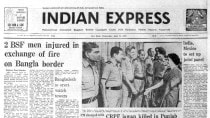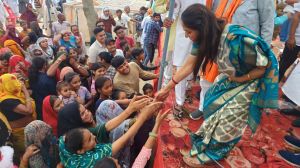- India
- International
An emotionally integrated India offers the best defence against both internal and external threats and challenges
As we move closer to celebrate the 75 years of our independence, our motto should be — perform or perish. This applies to all individuals and institutions. Realise your strength, build on them and create a united, prosperous India.
 The humiliating experiences of the last millennium should guide us. (Illustration by C R Sasikumar)
The humiliating experiences of the last millennium should guide us. (Illustration by C R Sasikumar)
The adjective “august” means respected and impressive, something special. The month of August has special significance in the history of modern India. The freedom struggle came to fruition on August 15, 1947. Five years prior to that, the Quit India movement was launched with a clarion call to “do or die” by Mahatma Gandhi on August 8. On the fifth of this month, construction of the Ram Temple in Ayodhya commenced. These events were a culmination of long-drawn struggles that offer certain lessons for the present and the future.
India’s independence was not just about the end of colonial British rule. It was also bringing down curtains on the dark age of about 1,000 years that began with the invasion of Mahmud Ghazni in 1001. It was the period when India’s inherent weaknesses were exploited by a regular stream of invaders, traders and colonialists. The socio-cultural-economic landscape of our country was brutally battered and exploited, enfeebling the masses.
The invaders had a free run coming in and looting at will. The lack of a sense of belonging to each other and the missing unity of action and purpose among the myriad rulers of the day made the country a soft target. Solo campaigns of brave resistance by the likes of Prithviraj Chauhan, Maharana Pratap, Chhatrapathi Shivaji, Rani Laxmibai of Jhansi, Veerapandya Kattabomman, Alluri Sitarama Raju were not adequate. Moreover, there were Mir Jaffers all through. A divided nation suffered from disgrace and dismemberment. Once rich, India was reduced to an ocean of poverty and backwardness.
During this long dark period, India lost its soul and inner strength. The people began to rediscover themselves as British colonial exploitation became evident. The freedom struggle brought the people together in the quest to shape their own destiny. It was rightly called the Indian National Movement as emotive nationhood gained currency. The follies of a long period of disunity were too stark to be ignored. Finally, the Indian nation was born on August 15, 1947. It is hence appropriate to say that the hard-fought independence was the liberation of our country from the dark age of centuries marked by lack of social cohesion and the glue of nationhood.
The Quit India movement was the most defining moment of our freedom struggle. The Quit India Resolution adopted on August 8, 1942, stressed that “…the immediate ending of British rule in India is an urgent necessity for both the sake of India and for the success of the United Nations. The continuation of that rule is degrading and enfeebling India making her progressively less capable of defending herself and contributing to the cause of world freedom.”

A few hours later on the same day, in his Quit India speech, Gandhi roared with a clarion call to the people to “do or die”. The apostle of peace and non-violence who lent a moral and mass dimension to the freedom struggle, using such language had rattled the British who were already reeling under the crippling impacts of the World War-II. Why did Gandhiji say so?
Since his return to India in 1915, Gandhiji steered the freedom struggle on a new path using the “force of truth” as a weapon to open the eyes of the British to the need for letting Indians govern themselves. His approach found resonance across the globe with British coming under pressure even from their war-time allies to mend their colonial ways. For long, Gandhiji engaged the British in negotiations, seeking to prevail on them. India was declared as a party to the Second World War without even consulting the leaders of the freedom struggle and the people. This incensed Gandhiji and others.
Fearing a Japanese invasion from the east and under pressure from the allies to gain the support of Indians for the war efforts, the Cripps Mission was sent to India. But it failed as it fell short of the demand for immediate independence for the country. Gandhiji who had a good measure of the mind of the British, their trickery of divide and rule and shifting goalposts, decided that it was the time to strike. The three words he used urging the masses to “do or die’’ had the fullest contextual justification and fired the imagination of the people. The then Viceroy Linlithgow unleashed violence to quell the movement, but it lasted for two years.
The freedom struggle was marked by different streams of thought and action. To start with, moderates like Dadabhai Naoroji and Pherozeshah Mehta took to petitioning the British for incremental improvements. Assertive nationalists like Lala Lajpat Rai, Bal Gangadhar Tilak and Bipin Chandra Pal believed in bold action. Revolutionaries like Khudiram Bose, Chandrasekhar Azad, and Bhagat Singh took to armed resistance. Netaji Subhash Chandra Bose revived the INA and sought Japanese help to evict the British from India. It was, however, Mahatma Gandhi who emerged as the voice of the freedom struggle for over 30 years.
Though territorially not integrated, the people had been in different kingdoms and provinces over the centuries, they were bound by shared cultural norms and values. Temples were key instruments of such cultural homogeneity. The foreign invaders were bent on destroying this cultural fabric. Major temples were attacked, looted and destroyed, resulting in sacrilege.
Mahmud Ghazni attacked the famous Somnath temple umpteen times during 1001-25. It took over 925 years to rebuild and restore it. It took about 500 years to start construction of the Ram temple. Such is the price paid for being divided for too long.
Some apologists of colonialism have sought to portray British rule as beneficial to India. Nothing is farther from the truth. All the initiatives of the British were guided by their commercial and administrative interests. The noted economist Utsa Patnaik, based on nearly two centuries of data on tax and trade, estimated that Britain drained about $45 trillion during 1765-1938 in different ways. This was 17 times the GDP of the UK. Indians were fleeced to support the advancement of the UK. During the 200 years of colonial rule, there was almost no increase in per capita income; during the last half of the 19th century, income in India dropped by half; the average life expectancy dropped by a fifth during 1870-1920. India would have emerged as an economic powerhouse if its revenues were invested within the country.
The humiliating experiences of the last millennium should guide us. The first lesson is — united we stand, divided we fall. An emotionally integrated India offers the best defence against both internal and external threats and challenges. We need to knit an India based on the principles of democratic-righteous governance that upholds equality of all and equal opportunities for all. We need to empower every Indian with the necessary tools to realise his or her fullest potential. A strong sense of Indianness that supersedes all other identities and a deep commitment to national interest should guide our actions.
In the present global order, it is the economic power that enables a nation to have its say. We need to fully harness our economic potential. For this, we need to scale new heights in scientific, technological, industrial and human resource development domains. The effective functioning of the legislatures, judiciary and the executive should be ensured by removing all the impediments.
As we move closer to celebrate the 75 years of our independence, our motto should be — perform or perish. This applies to all individuals and institutions. Realise your strength, build on them and create a united, prosperous India.
The writer is Vice-President of India
EXPRESS OPINION
More Explained
Apr 25: Latest News
- 01
- 02
- 03
- 04
- 05











































